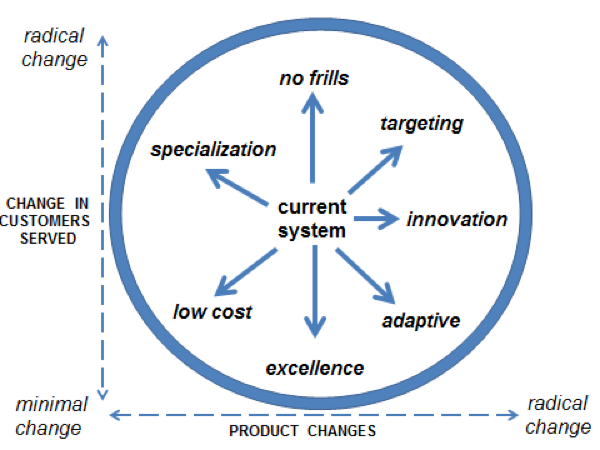Creating Value in Uncertain Times

Odgers Connect speaks with Dr Paul Raspin of Cass Business School for the latest insights on strategic planning for executives.
The traditional approach to developing strategy is based on the collection of past data points, and used as a predictor of future behaviour. Tragically, as we saw from the global financial crisis, this is fundamentally flawed as the unexpected does happen, often with catastrophic effects proving time and again that we simply do not have data points for the future. In the current Brexit environment we must employ a new kind of thinking when considering executive strategic decisions.
Organisations are subject to external forces, like Brexit, that are often outside of the control and plan of the organisation. The company is part of a ’macro’, increasingly perhaps irreversibly, global system: politically and economically, but also at a micro and local level with suppliers and customers. The company operates as part of an ecosystem. They DO influence but DO NOT control the system. With such limitations, companies need to a move to an agile strategy that adapts and evolves.
This theory is particularly suited to turbulent environments, where the value and indeed ability to execute traditional strategy is impractical. For example, heavy industries, like the oil sector will often plan investment and exploration years in advance, however a supermarket chain will need to respond to much more rapid changes in consumer demand trends, and are more suited to employing agile strategic planning.
Dr Paul Raspin, Cass Business School and Professor Cliff Bowman, of Cranfield School Management have spent years researching the interaction of complex systems theory, and strategic thinking, providing a practical guide to today’s leadership teams on how to create value in uncertain times and exert influence in the absence of control.
They consider the creation of value as the primary goal to focus on, and outline seven vectors which organisations can adopt to achieve this strategic outcome, whilst building in the agility to adapt to an environment in flux.
The vectors they identify are ‘Specialisation’, ‘Agile’, ‘Low Cost’, ‘Innovation’, ‘Excellence’, ‘No Frills’, and ‘Targeting’.
See chart at the bottom of the article
Source: Cliff Bowman and Paul Raspin, 2017
In the following case studies they highlight straight forward examples of how each vector has been successfully embedded in each business and with the correct strategic approach in turn creating competitive advantage and ultimately, value.
Bavaria Yachts has embedded the low cost value vector. This business is located among the agricultural heartland of Germany, miles away from the nearest body of water, yet has emerged as one of the largest and most successful boatbuilding companies in the world. A combination of German engineering precision, craftsmanship, manufacturing efficiencies, automation and adapting best practice from other sectors, has seen Bavaria Yachts deliver equivalent quality yachts at significantly lower costs that its rivals. This enables competitive pricing and delivers market beating growth.
From having no presence in the luxury car market Lexus has established a dominant position through the ruthless pursuit of an excellence vector. They have effectively achieved parity with European luxury vehicle manufacturers on key quality dimensions. This impressive result is the outcome of a deliberate and sophisticated engineering project that focused on the relentless pursuit of excellence.
SpaceX, established by Elon Musk to deliver re-usable space rockets, is an exemplar of the innovation vector. To meet this ambition requires extensive innovation across the process of design, manufacture, launch and recovery.
Zara the fashion clothing retailer is a good example of a firm pursuing an agile vector. Zara’s sourcing model sets it apart from competitors. The company owns all their own factories and they have a fast turnaround of products, so they can design and deliver new clothing lines to stores within three weeks.
A business that exemplifies the no frills vector is ALDI. A deep understanding of what price sensitive customers are looking for combined with a relentless focus on cost reduction across the entire system from sourcing, through merchandising, staffing, store management and inventory, has enabled ALDI to continuously grow.
Long Tall Sally, a clothing and shoe brand for tall women illustrates our targeting vector. The brand was established by Judy Rich, a UK domiciled American. At 5’11’ Judy struggled to find clothes that fit her well. Her experience was that clothes for taller women were simply made longer as opposed to being tailored for tall women. She opened the first store in the West End of London in 1976 and the chain has grown ever since.
Finally, their specialization vector is built around a specific product offering. A perfect example would be WD40 a product that is now in 4 out of every 5 American households.
Implications
By using the most appropriate vector as your compass, it is possible to test new strategies that enable the business to move forward based on the selected vector. Remember, the company is part of a complex system and each intervention in the system will have multiple positive and negative outcomes. Tests and pilot programmes enable companies to dip a toe in the direction you want to move. It’s then possible to assess the results, calibrate, refine and implement truly impactful results, harnessing value, within an organisation operating in an ecosystem in constant flux.
For more information please contact Maria Nally.

